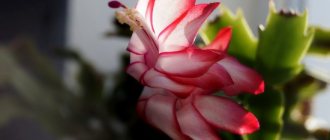Pachistachis is a representative of the Acanthus family. This genus of herbaceous plants includes 12 species. In nature, the flower grows in tropical and subtropical regions of America, and is also found in northern India.
In indoor floriculture, only 2 species are grown - yellow and red pachystachys. Despite its beauty, the flower is an infrequent guest in apartments. Many gardeners consider it capricious, so they do not undertake its cultivation. In fact, there is nothing complicated in caring for a plant, you just need to get to know it better.
Botanical description
Pachystachys is an evergreen shrub, a member of the Akataceae family, which is perennial. The distribution area of this plant is quite wide - it can be found in the tropical forests of Central and South America, on the east coast of Australia, and in Eastern India. Pachistachis usually reaches 1 meter in height , but some varieties grow up to 2 meters.
The shrub received its unusual name due to the shape of its flowers, which resemble a spike.
“Golden Spike” has straight shoots of medium thickness, topped with large oval leaves (about 10-12 cm in length), pointed towards the end.
The flowers of the plant are white and almost invisible. Pachistachis blooms for 10-12 days , after which the flowers fall off, but the bracts still remain.
The plant is notable for its inflorescences, formed from several bracts of bright yellow or orange color. Each bush produces 15-20 inflorescences; the bracts are pleasing to the eye from March to October.
Diseases
With proper care, the plant rarely gets sick.
| Symptoms | Causes | Elimination methods |
| Aphid. A sticky white coating appears on the leaves of the plant, as well as on the stems, then the leaves may have a black coating, and the stems seem to be fluffy, covered with aphids. | Leaves and stems need to be washed with warm water every day. If aphids are not immediately detected, then it is better to treat the leaves and stems once a week with Fitoverm or Intavir, you can make a regular soap solution. | Aphids do not like wet leaves and stems, it is recommended to spray the plant, and to prevent it from spreading to other indoor flowers, it is advisable to keep new ones away from others for the first time. |
| Shield. The leaves become sticky and wet. | Oval hard spots of brown color are visible on the candles and on the inside of the leaf. | The pot should be moved to a warmer room and treated with soapy water, and watered generously. |
| Powdery mildew. The plant begins to shed its leaves. | White areas with fluff are clearly visible on the leaves on both sides, which then darken and thicken. If this has been noticed recently, then it is worth spraying the plant for three weeks in a row (1 time each) with Topaz or making a tincture of garlic (infuse for a day in a dark place, washed out garlic (30 g) in a liter of water). | Powdery mildew settles only on frail flowers; prevention is to feed and water the plant. |
| Spider mite. A barely noticeable web appears on the plant; if you look closely, you can see small mites. | It is necessary to carry out a one-time treatment with Ftover or Taurus. | The mite does not like water, you need to constantly spray the plant, put the pot on a tray with water, you can put expanded clay. |
With proper care, pachistachis will always delight with its flowering, fitting perfectly into any interior, both at home and on verandas and balconies. No wonder it is popular among gardeners not only due to its flowers, but also its bract in the form of a bright spike.
Varieties and photos
There are approximately 12 varieties of Pachistachis, of which only two are suitable for indoor growing. Below are photos, names and descriptions of pachistachis varieties suitable for propagation and care at home:
Yellow
This variety is distinguished by yellow spikelets and is the most popular among gardeners. Pachistachis yellow has straight stems, which become woody as the shrub grows. The leaves of the plant are large - up to 5 cm wide and 15 cm . in length. You can see what the Pakhistachis Yellow variety looks like in the photo below:
Red
Unlike the previous variety, the flowers of the shrub do not hide among the inflorescences, but rush upward in the form of red panicles. This variety is also notable for its larger size. Pachistachis red grows up to 2 meters in height and requires a lot of space. The bracts are greenish in color and the red flowers stand out against the green foliage. In the photo below is the variety Pakhistachis Red:
Types of pachystachys
Pachystachys yellow
The most popular among flower growers is yellow pachystachys (Pachystachys lutea), a description of which you can find at the beginning of the article. However, this is not the only species grown indoors.
Red Pachystachys (Pachystachys coccinea)
Typically, this species is grown in greenhouses because its height can reach up to two meters. The short-petioled, rich green leaf blades reach a length of about 0.4 m. There are burgundy stains on their surface. During flowering, the bush is decorated with green bracts, as well as tubular elongated red flowers, similar in appearance to feathers, which in the recent past were used to decorate hats. It is because of the unusual inflorescences that the species is also called the “cardinal’s guard.”
Pachystachys spicata
This species can be found in botanical gardens, but is grown very rarely indoors. Its dark green leaf blades reach about 25 centimeters in length. During flowering, deep red flowers open on a cone-shaped bract. Some experts believe that this is a variety of pachystachys red.
Care
“Golden Ear” is accustomed to tropical growing conditions, so the main task of the grower is to create an optimal environment for the healthy growth of the exotic shrub. We'll talk further about how to properly care for pachistachis.
Lighting
“Golden Shrimp” will need a lot of light, but remember the main rule: when placing the bush on a south window, create light partial shade , otherwise bright rays will damage the leaves and the flower will die. In winter, take care of additional lighting.
Temperature
This plant will need an average temperature of 20-24 degrees in the spring-summer period and 16-19 degrees with the onset of cold weather. A mark of 14 degrees will already be critical for the flower and threatens its death.
Avoid drafts in the room, and do not place shrubs close to radiators.
Humidity and watering
Pachistachis loves high humidity - this applies to both the soil in the pot and the air in the room where the plant is kept.
On warm, sunny days, watering should be plentiful and regular; do not allow the earthen ball in the flowerpot to dry out. In the autumn-winter period, the flower should be watered as the top layer of soil dries.
Sometimes add an infusion of onion peels or ash to the water for irrigation - this will have a beneficial effect on the health of the bush. Use only settled water at room temperature.
Spraying in the summer should also be regular; if there is a lack of moisture in the air, place a vessel with water next to the plant or place the pot on a tray with wet peat or pebbles.
Top dressing
During the period of intensive growth, the shrub will need help in the form of fertilizers. The frequency of feeding is from April to October.
The following remedies will have a beneficial effect on pachistachis:
- "Universal";
- "Aquarin";
- "Bioton";
- "Living Force";
- "Agricola".
They should be applied no more than once every two weeks.
Transfer
Transplantation is carried out before flowering begins, in early spring. The frequency of replanting depends on the intensity of shrub growth. So, adult flowers are replanted once every 3 years .
The soil for replanting is prepared in advance. It should be disinfected within two weeks by watering it with a solution of potassium permanganate or heating it in the oven.
The procedure is as follows:
- before transplanting, we prune the flower, removing excess shoots and dried leaves;
- Cover the bottom of the pot with a drainage layer;
- transfer the plant from the old pot to a new place;
- pour the soil mixture into the pot, filling all the voids and compact it thoroughly;
- We water the transplanted bush and keep it away from bright rays during the adaptation period.
Priming
We cover the bottom of the pot with expanded clay or pebbles, after which we add the substrate. The recommended soil composition should contain several components taken in equal proportions:
- leaf soil;
- peat;
- turf;
- humus;
- river sand (coarse-grained).
If you do not want to prepare the soil mixture yourself, purchase ready-made soil for beautifully flowering ornamental plants.
What soil do you prefer to use?
PurchasedI make my own
The thickness of the drainage layer should not be less than 3 cm.
Trimming
If there is no pruning, the bush will stretch out, lose its splendor, and flowering will be sparse.
Therefore, pruning of adult plants should be done every spring. Young bushes are pruned when the shoots reach 10-15 cm in height - then they should be pinched or cut.
Peduncles of this plant appear only on young shoots , and flowering begins only in the third year of life.
Further pinching should be done every spring. To do this, we retreat from the top of the flower by 2 pairs of leaves and pinch them off. This way you will get a beautifully shaped bush that will delight the eye with its lush foliage and abundant flowering.
By winter, when Pachistachis stops blooming, it is necessary to cut off its bracts - they are cut off along with a pair of leaves located below. This pruning method will help achieve branching and rejuvenate the bush.
Problems encountered during cultivation
Pachistachis is rarely attacked by insect pests. Dry air can cause the plant to become infected with spider mites. Regular spraying of the crown will help avoid this. If pests do attack the bush, acaricidal drugs are used - Apollo, Fufanon and others.
Read about Roundup. Instructions for use.
Sometimes the bush is affected by other insects, for example, whiteflies and scale insects. They can be seen with the naked eye. In the first case, small flying flies circle over the plant. In the second, brown plaques 1.5 mm in size are visible on the underside of the leaf. Insecticides are used to combat them.
Most often, the plant gets sick due to the grower’s mistakes. Common problems and solutions are described in the table.
| Problem | Causes | Recommendations |
| Yellowing and dropping of leaves during the growing season and during flowering | The reason is lack of moisture | It is recommended to adjust watering and spray more frequently |
| The leaf plates have lost their saturation, the flower is stretched | Bad light | You need to move the pot to a well-lit place or illuminate the plant with fluorescent lamps |
| Dropping leaves in winter | The room temperature is low, the plant is freezing | The flower should be moved to the warmest room where the temperature does not drop below +22 ºС |
| The edges of the leaf blades have turned yellow | Low air humidity | It is recommended to use a humidifier or place the pot in a container of water. If the flower is near heating radiators, you should remove it from the windowsill |
| Dark spots have appeared on the leaves or shoots, the plant is withering | Root rot, waterlogging | It is necessary to replace the soil in the flowerpot, remove damaged roots, reduce watering |
| Flowering does not occur | The cause may be several factors - lack of nutrients, low air temperature, improper watering | Increase fertilizing, but introduce them in half the dose, find a warm place for the plant with good lighting |
| The stem at the bottom of the bush is exposed | The plant is old and needs rejuvenation | The problem can be solved by pruning. By shortening the stems to a length of 12 cm, the grower stimulates the growth of side shoots |
Even a novice gardener can take care of pachistachis. The tropical guest is not so demanding. The main thing for him is high air humidity, correct temperature conditions, frequent but moderate watering and regular feeding. Formative pruning will promote good branching and abundant flowering.
Reproduction
To get new plants, you need to know the possible methods of propagation. "Golden Ear" propagates by cuttings and seeds. We'll talk about each method further.
Cuttings
Cuttings are harvested immediately after flowering. To do this, take cuttings that have at least 2 leaves . Followed by:
- Place the cuttings in a container filled with a growth stimulator (you can take “Kornevin”), and then plant them in the prepared substrate.
- Cover the cuttings with a jar or plastic and place them in a well-lit place.
- When young shoots form, remove the jar. At this time, the lower leaves will die off.
After 15-20 days you will be able to see the first flowers.
Note that propagating shrubs using cuttings is the most popular method, because the result will not take long to wait.
Seeds
Planting seeds occurs with the arrival of spring and consists of several stages:
- Prepare the substrate for planting in advance. To do this, take a medium-sized container. Be sure to moisten the soil.
- Sow the seeds evenly and cover future plants with film to create a “greenhouse” effect.
- As the substrate dries, carefully spray the seedlings. In addition, regular ventilation is necessary.
- As soon as the shoots appear, remove the film.
- When the first leaves appear, plant the bushes in separate containers.
Peculiarities
For abundant flowering, the plant must be kept in winter at a slightly lower temperature (16-19°C). At this time, its watering is slightly reduced, watered every 10 days and only after the top layer of soil dries. Fertilizing is not carried out in winter.
In order for Pachistachis to bloom for a long time and luxuriantly, it is necessary to create the following conditions for it:
- Plant the plant in a cramped pot so that the plant does not waste time developing the roots of a large earthen coma;
- Plant several cuttings in one flowerpot to form a lush bush;
- Carry out regular pruning of the bush, since inflorescences form only on the tops of young shoots;
- Be sure to feed the bush during the growing season and flowering.
The first pruning of young pachystachys is carried out after the appearance of two or three internodes. The top of the cutting is pinched at a distance of 15 cm from the ground, stimulating the growth of side shoots. After additional shoots appear, they are also pinched when the third pair of leaves appears on them. After the bush blooms, each crown is cut off, and 2 shoots grow at the cut site.
Diseases and pests
Mature shrubs, as a rule, are not prone to disease. The main problems arise from improper care. Let's talk in more detail about how to act in each situation.
Why do the leaves curl?
Curling and falling leaves can most often be seen during the cold season. The main reason is uncomfortable living conditions. Most often these are drafts, as well as temperature changes .
The second reason is too much water in the soil.
Do not forget to drain excess water from the pan, do not allow moisture to stagnate in the roots - it can have a detrimental effect on the well-being of the flower.
Why doesn't it bloom?
It also happens that the bush does not form flower stalks. This is due to two factors:
- lack of spring pruning;
- the plant does not have enough light.
Getting a healthy, flowering shrub is not difficult - it is only important to eliminate the listed reasons in time and pay maximum attention to the flower.
Leaves turn yellow and fall off
Yellowing and subsequent falling of the foliage indicates non-compliance with the recommended temperature regime .
Remember that too high a temperature leads to plant diseases. In winter it should not rise above 16-18 degrees. A pot with a plant can be placed on a closed loggia.
The leaves turn pale and wither
This condition is due to three reasons:
- Excess sunlight.
- Rare watering.
- Lack of nutrients in the soil.
The bush stretches out
When the stem of a bush grows strongly and it loses its beauty, take care of proper lighting . Move the pot to a brighter place, and then use pinches to give the flower the desired shape.
During this period, the plant will need abundant watering.
Note to the florist
Why do pachystachys leaves curl?
As a rule, the reason lies in non-compliance with growing rules:
- The air in the room is too dry, especially in the autumn-winter period, when the heating system is turned on. You can simply fix the problem by placing the flowerpot with the plant in a tray with wet pebbles or expanded clay;
- Sudden temperature change. In this case, the leaves not only curl, but may also fall off.
Why doesn't Pachistachis bloom?
There may be several reasons:
- Insufficient lighting, it is best to grow the plant on east or west windows;
- Due to insufficient nutrient content in the soil, pachistachis needs to be fertilized with organic and mineral fertilizers in a minimum concentration, and the frequency of fertilizing is once every ten days.
If you want your home to be decorated with a plant that blooms from spring to autumn, pay attention to pachistachis, an amazing flower from the tropical forests of India and Australia. There is an opinion that the plant is difficult to grow at home, but experts assure that this is not at all the case. The main thing is to provide the flower with high air humidity, protect it from direct sun and drafts, and also prune it regularly and you will certainly grow a lush, bright pachistahis bush.
Signs and superstitions
There are several signs associated with growing the “golden shrimp”:
- The purchase of a healthy flower will provide a new outbreak of feelings in the family, but it needs a return. The plant may lose its properties if there is betrayal in the family.
- Pachistachis provides powerful support in the home even though it does not have protective properties.
- The flower helps get rid of sudden mood swings and is especially important for choleric people.
- If the leaves of a flower are curled, there may be financial problems in the house, so pay great attention to air humidification and pest prevention.
- Abundant flowering portends a happy event.
- When the “golden shrimp” loses its flowers and the leaves of the plant dry out and fall off, expect bad news from loved ones.
Pachistachis is not picky about growing conditions and does not require special care at home, but its basic preferences should be taken into account. The plant will delight conscientious owners with unusual, bright flowers.
Transplanting and rooting a plant
For transplantation, you need to carefully prepare. Pre-prepare the soil so that the plant takes root in a new place. There are special transplantation rules that will allow it to quickly grow and bloom.
Soil preparation
Peperomia - flower care at home
In ordinary soil, the flower may not take root. Therefore, first buy a universal mixture in the store, which is intended for ornamental plants. If you wish, you can prepare it yourself. To do this, mix equal parts:
- sand;
- humus;
- peat soil;
- leaf soil.
Important! To ensure immediate growth, it is recommended to add 2 times more putrid turf soil.
For replanting, the soil must be loose. This ensures the passage of oxygen and moisture to the lowest roots. Thanks to this, the root system will begin to increase in size, preventing the possibility of rotting.
Transfer
The procedure is carried out every year in any month of spring. It is better to do this when the flower has survived the pruning procedure. For replanting, the entire root system is dug up. The plant is placed in a new pot, into which a mixture of various types of soil has previously been added. In addition, the pot must be lined with a drainage layer in advance to prevent water stagnation.











